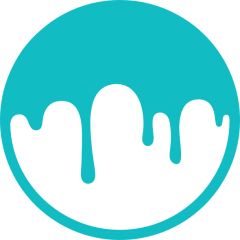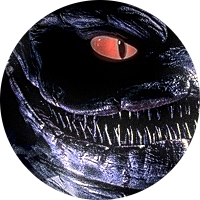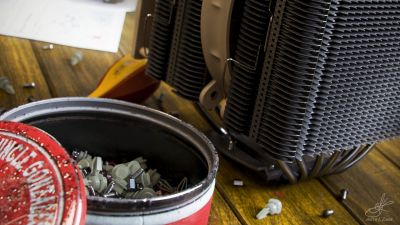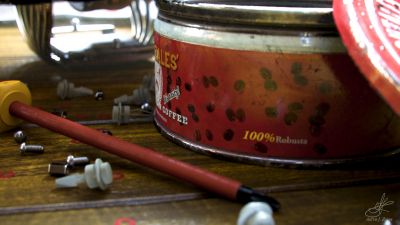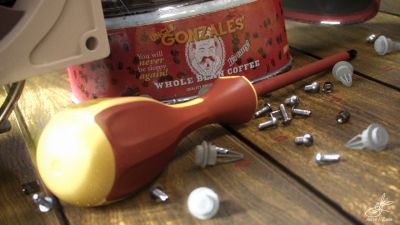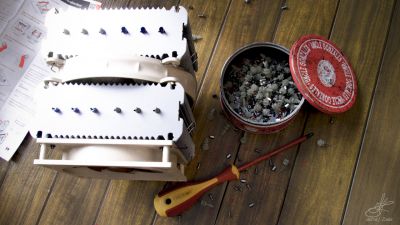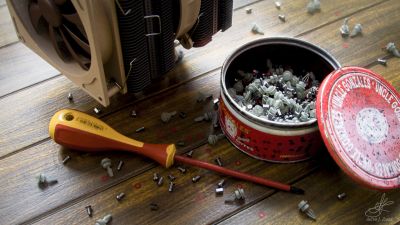Search the Community
Showing results for tags 'udim'.
-
I would post this in the appropriate forum section but I don't seem to have the permission to create a topic there. There was a similar feature request from 2014 on Trello here: https://3dcoat.com/mantis/view.php?id=1102 This request is for UDIMs(which 3DCoat doesn't seem to officially support and treats as additional UV sets). We have a 1MB FBX asset, when imported It uses around 40GB of RAM to support 20 UDIMs at 4k. We'd like to work with 8k but the way 3D Coat seems to handle this is keep all textures in memory even if no colour data is painted on or loaded in via textures? We already have the 8k textures from an external bake and would like to bring these in to do some post work with 3D Coats tools, the required amount of memory is a bit of an issue. This feature request is about importing multiple textures at once(our UDIMs), if 3D Coat supported UDIM layouts properly it should be able to easily infer the appropriate textures for each UV set(which is named by it's UDIM ID in our case). All that needs to happen is provide a list of textures or a folder containing them, remove the extension from the file and look at the last 4 numbers for the UDIM IDs to match their UV set. I considered trying to implement this via the Angelscript support, but did not see any information on how to perform these actions with the docs I came across? Additionally to handle memory issues, would it be possible for 3D Coat to allow a disk cache/scratchdisk to be set by a user to write/read the individual textures from and to until the user actions a save? This way 3D Coat could perhaps use a format where it only reads in the mipmap data of an appropriate resolution or separate files only keeping textures in memory when they're in the viewport and proxying others based on viewport culling or screen/viewport size, ie 512 or 1024 px maps could be used elsewhere on the model data, and keep memory usage down, only presenting/using actual texture when applying paint or some other conditions? I'm not sure how the software Mari or others might approach it but it'd be great to use 3D Coat for this workflow. We have one asset with 100 UDIMs that just wouldn't be possible to work with in 3D Coat beyond setting very low texture texture resolution and manually adjusting the size and textures loaded in. Is there a way to fund features/priority in any way? I can understand this may not be as useful/valuable to the existing 3D Coat userbase much, it could attract a new community of users that do have these needs.
- 8 replies
-
- multiple textures
- feature request
-
(and 2 more)
Tagged with:
-
Hi, Would be great if we could import multiple textures via UDIMs in 3DCoat. Similar to other applications, when you import one texture that's a part of a UDIM set, all associated textures that are part of that UDIM are automatically loaded as well. Since 3DCoat supports the UDIM ID's would it be possible for 3DCoat to do also do this, and map the textures to the UV tiles (3DCoat UDIM's) Thanks.
-
Hi There, I've got the demo version of 3dcoat at the moment and was looking to bake maps for some large assets. Every time I try to load the obj in I get an 'square of the uv set is too big' error. Is there a limit to the amount of tiles you can bring in? Most of the assets I'm working on are around 70 or so tiles and sometimes up to 200 udims/tiles. Before anyone asks, yes, I do need that many tiles Sometimes the camera is rubbing up against the asset. Cheers, Mark
-
Hi guys! I do need urgent help here, so please consider this: I have a turbosquid .obj file (purchased legally) and I need to open it (flying dino) it's an obj. It has UDIM style UVs 3 tiles to be exact: 1001,1002,1003 and everytime I try to open it with different settings (default import, clicking import tiles as UV sets etc) I have no luck. First I had crashes, but that was due to having multiple mesh islands combined having overlapping UVS and multiple UV sets (probably a no-no) solved that. I can import the single mesh piece finally but now at least one of three tiles gets abnormally scaled in U or V direction?! making it useless. The best result so far was having two intact UV tiles 1001 and 1002 but the third tile for some reason goes nuts. if anyone can open it in any 4.x version of 3DCoat I'd be greatful to learn about what I'm doing wrong. Thank you for any and all help: The .obj in question is here: p.s: I'm using the latest 4.9.04. version. And the model works fine in a special UDIM branch of blender (all UDIM tiles are intact), but I'd rather paint textures in 3DCoat for obvious reasons. ptera_body.obj
-
Texturing is central to 3D. From UV to UDIM to Ptex, it is easy to think one technology has just displaced another, but the reality is more complex. UDIM UV mapping has enormous popularity for texturing in the face of much newer systems such as Ptex (which works very well in its own right). While Ptex may still yet win the texturing heart of pipelines around the world, it has not yet become the dominant force. The article at FXguide UDIM is a way of creating a single linear number that identifies each integer block in UV space. You do this by defining a limit on the number of patches you can use in the U direction (the U-DIM) and then resetting U to 0 and incrementing V by one after reaching that number. i.e. fill in all the patches up to U=10, then go back to U=0 and go up a line in V. In fact, while UDIM could use an U base number, 10 is now the default and almost exclusively the only number used. The UDIM number starts at 1001 with the U=0,Y=0 being 1001. //note: Proper UDIM support in 3DC was implemented after v4.5 BETA4
-
https://www.fxguide.com/featured/udim-uv-mapping/ Texturing is central to 3D. From UV to UDIM to Ptex, it is easy to think one technology has just displaced another, but the reality is more complex. UDIM UV mapping has enormous popularity for texturing in the face of much newer systems such as Ptex (which works very well in its own right). While Ptex may still yet win the texturing heart of pipelines around the world, it has not yet become the dominant force.
-
Is it possible to layout UDIM UVs in 3d Coat, actually ?
-
Hello When painting multi tile mesh in paint room If you use the blurring tool at the boundary, strange edges will appear. What should I do?
-
Hi everyone, I'm looking for a udim workflow from 3d coat to mari. I know that I can unwrap my uv's into separate tiles in 3d coat, but is there a way to export those tiles as udims for mairi? I've been searching for an answer on this and I am unclear if this is something I can do with 3d coat. Any help would be much appreciated, thanks! Max
-
3dCoat 4.7.06 After importing model with only "Treat materials as separate textures" checkbox set on , everything seems to be ok, but ambient occlusion can be baked only for the first UDIM square. All the other (outside main UV area) don't bake http://take.ms/fi3PX it's strange because Curvature is baking fine http://take.ms/ISAhF
-
Hi, Guys. I'm experiencing some problems here on my workflow. I have a model separeted in various objects. Each one have its proper UVs and everything is on place, no UDIM (despite using UDIM would be good. But when I do import with Importing Titles as UV Sets all my UVs are stacked on each other). When I import OBJ file to PPP workflow, 3D Coat shows this screen. T The problem is: I have 12 objects with UVs but it only shows 6 UV sets on the importing options. When I click OK, suddenly 3D Coat shows 6 UV sets and 6 surface materials (of 12 objects) and the result is some UVs stacked on each other, also my UV names are not the same as I created, as you can see on the image: When I try to import a FBX file instead of a OBJ file, it shows ALL of my UVs on the importing screen and PRESERVING the UVS names, which is really good. However, the problem with FBX importing is this. While all my UVs are absolutely perfect, the model itself isn't as you can see on the image. If I try to subdivide de model on importing screen, the result is: Some additional info: Tested with 3D Coat 4.5.19 (trough Steam) and 4.5.29. UVs are created on MODO 902. Thanks in advance.
-
Hi, everyone, first post here though I wouldn't say I'm exactly a new user. I've been using 3D Coat off and on for the better part of this year, and while I've been able to get most of my questions answered viewing many of the videos that have been made, I've been extremely stumped on this one particular issue: How to bake out UDIM UV sets from the retopo room. So many invisible walls with this one it seems... I can create PLENTY of new UV sets inside the retopo room and place unwrapped islands into any UV set I create... this part is easy and obvious. The issue is when I bake for PPP (non-displace/normal baking) and choose "UV MAP TYPING: KEEP UV", It collapses all the UV sets back into the default UV set completely ignoring the other UV sets I've made. What's the "correct" way of preserving each UV set? The only workaround I've been able to come up with, is to move each UV set that isn't 1001/default to the next available UV space. When I do this, the bake works fine and I can see the UV sets I've moved out in the UV set list in the paint/UV rooms. Only problem: 1) if two UV sets occupy the same UDIM/UV space, those get collapsed into it's corresponding UDIM set when baked from Retopo, and 2) it's becomes difficult to determine the area of each UV quadrant boundary after the immediate top/bottom/L/R spaces are filled. 2 quadrants in any direction and it becomes difficult to 'guess' if you've hit a border or not. So my question to the forum is, what is the best way to preserve UV sets when baking out of the retopo room? Is there a numeric U/V value input when transforming islands within the Retopo UV toolset so there's precision with placement? It may seem trivial but we rely on UDIM-based UVs for our pipeline and it just seems to me that I'm missing a critical workflow process/step or something and it would save me a lot of time if laying out of each UVset happened the way I would assume it should. I appreciate any feedback anyone has on the subject. Thanks!
-
From the album: Nuts and bolts
© Artur J. Żarek, 2015
-
- pbr
- subdivision surfaces
- (and 7 more)
-
From the album: Nuts and bolts
© Artur J. Żarek, 2015
-
- pbr
- subdivision surfaces
- (and 7 more)
-
From the album: Nuts and bolts
© Artur J. Żarek, 2015
-
- pbr
- subdivision surfaces
- (and 7 more)
-
From the album: Nuts and bolts
This was tricky. I really liked the shot, but it revealed an awful seam in the pattern of the floor, on the leftmost side of the frame. I had to come up with something to cover it and ended up with a scanned NH-D14's user's manual. That's an awesome CPU cooler, by the way. I recommend it to anyone with a compatible CPU. Quiet (low-RPM) yet very powerful - thanks to a huge heat dispersion surface of radiator ribs.© Artur J. Żarek, 2015
-
- pbr
- subdivision surfaces
- (and 7 more)
-
From the album: Nuts and bolts
© Artur J. Żarek, 2015
-
- 3
-

-
- pbr
- subdivision surfaces
- (and 7 more)


